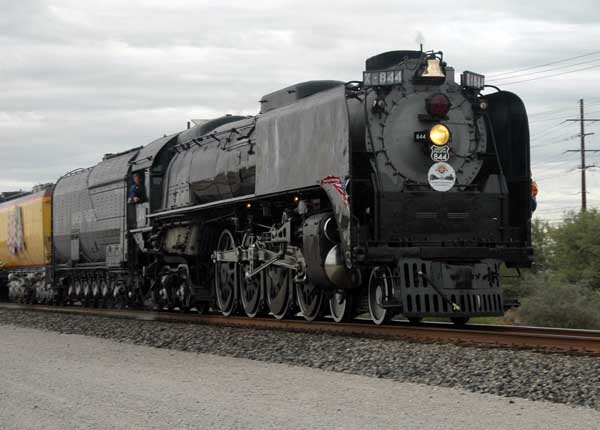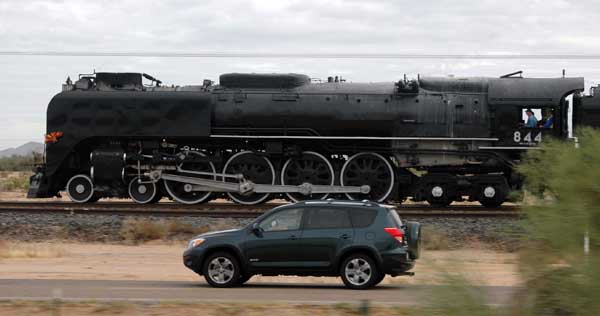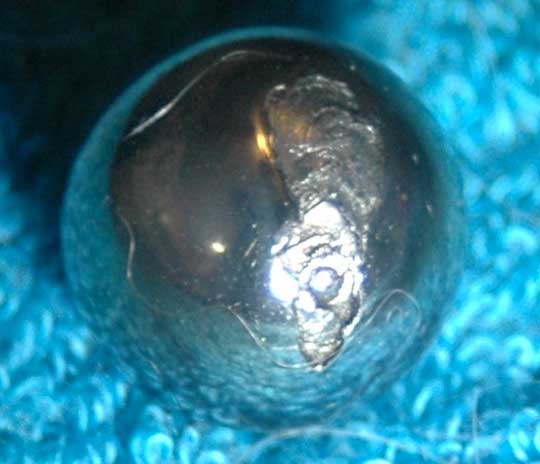| I have come to embrace certain aspects of the digital revolution. An example is the speedometer on my bicycle. Had I to choose between riding sans speedometer and riding with only one pedal, I would have to think about it awhile. In the "old days" bicycle odometers consisted of a peg attached to a spoke that moved a toothed wheel one fifth of a revolution on each pass. Adjusting the clearances was tricky, and at high speeds the toothed wheel tended, occasionally, to move more than one fifth of a revolution, making the next pass of the peg on the spoke a little more violent than one might wish. Further, of the several I had, none lasted much past 300 miles. The one pictured here has lasted a bit longer, although the battery is just about dead. |

|

|
The Union Pacific Railroad maintains an antique steam locomotive (the last one they purchased before switching to diesel powered electric engines) and on special occasions, trundle it out for display. I'm not exactly sure what they are commemorating, but the engine, with about a dozen cars, is making a loop from its home in Wyoming through Colorado, New Mexico, Arizona, California, Nevada, and Utah. One problem with still cameras is they don't imply motion. In this image the beast is thundering along at about 65 mph. |
| Nathen, who works on what amounts to stationary steam engines, was taken by this mobile one, and I accompanied him on his second visitation. |

|

|
Nathen also brought Jim (who back in '37) actually rode a steam powered passenger train from Texas to California. We stood on the Campbell Avenue over-pass, and as the engine rolled under it, the engineer treated us to a blast from his steam whistle. That sound could be heard all over town, and at a distance of less than 50 feet, it made my ears ring. Jim, who had his hearing aid turned off, claimed he could feel it but not hear it... |
| After returning Jim to his home, Nathen and I raced the train to Marana, where we took a video of it. We then raced it to Picacho Peak, where we took another video (with the train going markedly slower). We then race it a third time to an unscheduled, 4 minute, stop just outside the town of Picacho, where we got some up-close photos. |

|

|
This is one of the pistons that drives the wheels. There is one on each side. The drive bar attachment to the wheel on one side of the axle is 90° out of phase with the attachment of the drive bar to the wheel on the other side of the axle, so that if one piston is stopped at top dead center, the other can still supply motive force. This photo just doesn't do justice to the massiveness (the larger of these two wheels has a diameter that rivals my height) and noise associated with this machinery. |
|
I neglected to document it photographically, but after the train passed, there was a trail of water splattered along the bottom flange of the rails. The most logical explanation was that it came from condensing steam, but there sure seemed to be a lot of it. This was kind of a fun adventure, and I suspect it will be a number of years before I hear the unique wail of a steam whistle again. |

|

I had a boss at one time who, when I would do something meritorious, would say, "Even a blind squirrel finds an acorn occasionally." Well, I wasn't an acorn, but I did find this camera by the side of the road. It has some scuff marks, as if it had fallen off a moving vehicle, but it is still functional. There were somewhere in the neighborhood of 350 photos on it, (some of a flooding river), but I was unable to identify who might have owned it. The make is Kodak, and the model is Easy Share, but that name is deceptive. It took me almost a month to figure out how to download photos. The photo size is 10.1 mega pixels, but the price new was around $75, so you can surmise it isn't much of a camera. Further, there is a lag between pushing the button and hearing the shutter click, and after capturing one image there is a lag of almost 12 seconds before you can capture another. Still, the price was right... |
| The brakes on my Geo started making a metal on metal grinding sound. I ignored it as long as I dared, but finally tore into it. The pad themselves still had about a millimeter left, but there was a place where the brake backing was rubbing on the rotor. The whole brake replacement took only 25 minutes, and if the story ended here, it would be a happy tale indeed. |

|

|
Unfortunately, one of the CV boots was ruptured. So, I purchased a replacement boot and a few days later attempted the replacement. The half axle came out easily, and I cleaned out the old grease without incident. Then, just as I prepared to repack the CV joint, I noticed a small imperfection in one of the ball bearings. Closer inspection revealed another imperfection, then another, until I found this. Auto focus cameras have difficulty capturing the surface detail of a shiny steel ball, but this image should be sufficient to convince even the stanchest skeptic that this joint had progressed a significant distance along the road to failure, and could be repaired only by being replaced. |
| After a couple of terse telephone conversations, Lady Luck smiled on me and I located a rebuilt transaxle in Tucson. Surprisingly enough, reassembly was unremarkable. But... One end of the transaxle sits in the transmission, such that removing it causes the loss of some oil. According to the manuel, the filler hole/level indicator is located on the front of the engine. Not so! Google located a site that placed it on the side of the transmission, and there is something there... but I don't own a tool capable of persuading the plug to budge. |

|

|
The proper oil level is achieved by inserting a tube into the filler hole and pumping in oil until it runs out faster than you can pump it in. Lacking access to this hole prompted the implementation of "Plan B." The bottom of the transaxle exits the transmission about 5 to 6 inches below the bottom of the filler hole. I reasoned that if one were to tilt the transmission until the bottom of the transaxle port was level with where the filler hole had been, the transaxle port could be used as a filler hole. I have since had several debates with myself concerning the validity of that logic, but so far it seems to be working. Raising the vehicle that high with only one jack took a bit of ingenuity, and once or twice introduce a twinge of excitement in my otherwise staid life (fortunately the wind wasn't blowing), and as Shakespeare opined, "All's well that ends well." |
|
AJ and Brittney have another vehicle, and since they haven't figured out how to take and post images, I took the liberty to visually enlighten the rest of us. They sold their other car, basically because they couldn't keep the AC functional. Since AJ claims the truck, Brittney got to choose this one. Her criteria were, "A cute car at a cute price." This is a Ford Fusion (I think) and, hopefully, meets those requirements. (And just for the record, the date stamp on all these images is not correct.)
|
 |
As I move through life, I see more and more ironies in the English language. When it was first introduced, the automobile was named by combining two words: auto meaning self, and mobile meaning moveable. Literally it was, "self-moving." Common usage shortened it to "auto." Then came the publication, Auto Trader, meaning literally, "self-trader." I don't think I'll pursue that line of thought any further... In an analogous manner, the harpsichord (an instrument that created music by wooden hammers striking stretched strings) produced a sound having only one volume level. It was replaced by similar instrument that could be played loudly (forte) or softly (piano). Originally it was called a, "piano-forte," but was shortened by common usage to,"piano." So, now when you go to church, you hear a "soft" playing. And, in defiance of its name, it is occasionally played loudly. |
|

|
Karren and I drove to Woodruff to visit Mark et. al. Karren is one of those "odd" people who works nights. As a consequence, it is her custom to take a short nap whenever she goes visiting. Maybe that is why she has difficulty scheduling visiting teaching appointments... |
| I enjoyed visiting with Mark. The chemotherapy he is taking exacerbates nascent cataracts, and he had surgery on his left eye the day before we came. He said the surgery has improved the vision in that eye remarkably already. |

|

I have been wanting a headphone extension cord for quite sometime, so when I (literally) ran across this ipod while bicycling at lunch, I was only too happy to bring it home. Taking an ipod apart is more of a challenge than one might think (Would you believe 15 minutes with a hand-held grinder?). When I was finally successful in extracting the plug-in jack, I discovered that the contacts are so small that attaching wires to them (using any tool at my disposal) is impossible. Still, it was an entertaining exercise. |